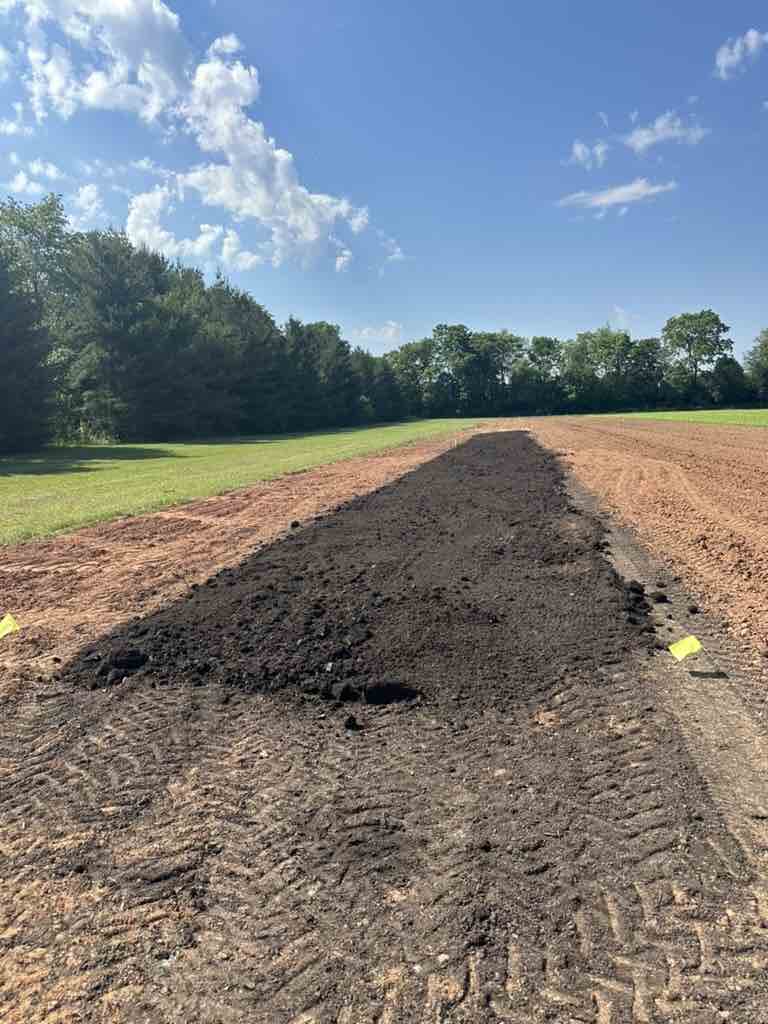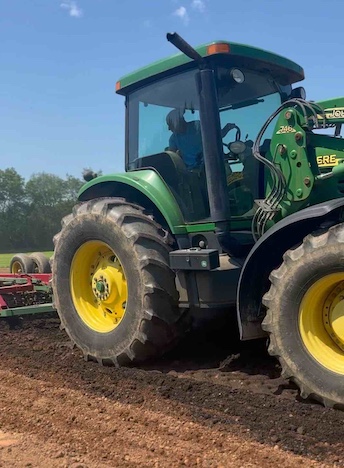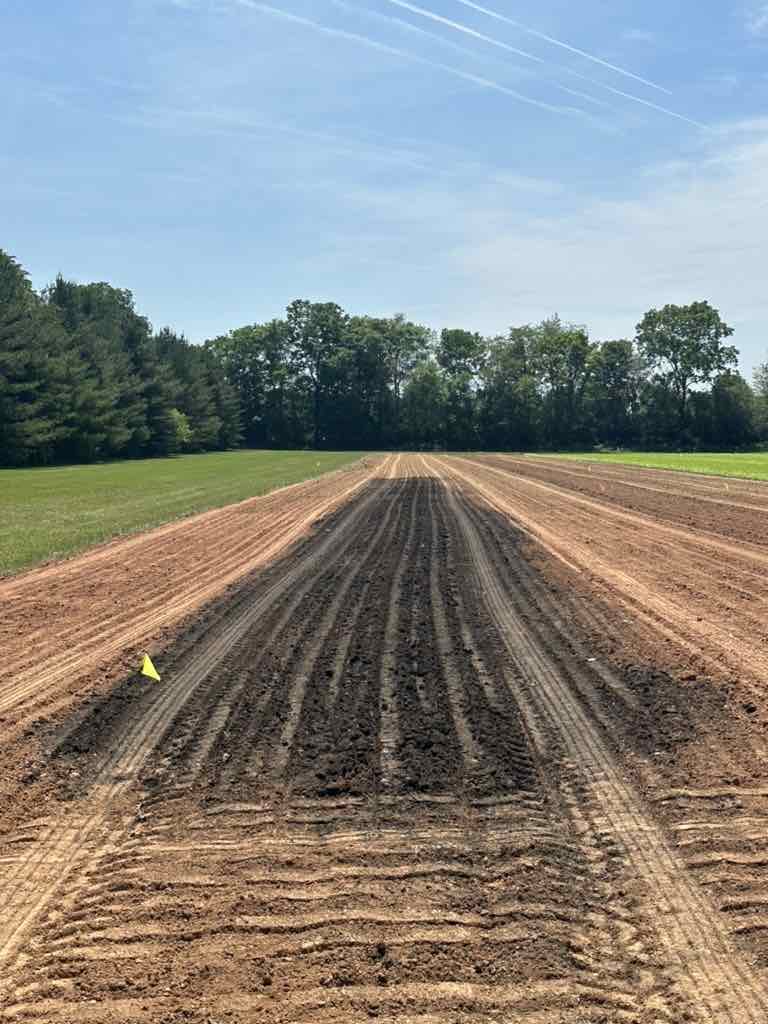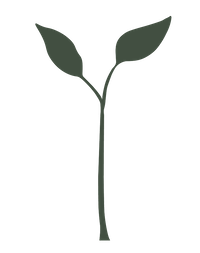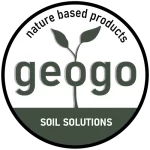May 2024 : Start Trial
geogo Soil Solutions collaborated with Bullfrog Sod in Adamstown, MD to do a trial of a custom blend using our geogo Xtreme Bokashi Compost at 20%.
The goal was to better understand how plants responded to our Xtreme Bokashi Compost in a blend compared to synthetic fertilizers. The blend was expected to improve and help regenerate the soil by adding living microorganisms, minerals and nutrients that plants could benefit from.
geogo Soil Solutions Hemp Trial in Adamstown, MD 2024
May 22, 2024 was the beginning of the Hemp Trials at Bullfrog Farms in Adamstown, MD. The trial consisted of a 20% blend of geogo’s Xtreme Bokashi Compost,
synthetic chemical fertilizers, and a control group. All results were documented. For all test plots, no irrigation system was used. Irrigation
was from rainfall only. No pesticides were applied to any of the test plots.
Prior to May 22, 2024, the test plots were tilled and prepared. Each plot measured 150′ long by 7.5′ wide. On May 22, 2024, the custom blend
was applied for each test plot by a tractor and spreader. For the 20% geogo Xtreme Bokashi compost blend, we did a top dress of 3-4″. For the synthetic
fertilizer plot, a fertilizer with a per acre analysis was applied: 100 lb Potash (60% K), 100 lb of MAP (11% N / 52% P), 50 lb Ammonium Sulfate (21% N / 24% S), 220 lb Urea
(46% N), and nitrogen stabilizer to prevent nitrogen loss). No materials were applied to the control plot. It goes to make a note that the
soil beneath leans to a clay like as it is a sod farm. After finishing with applying the blend, a harrow worked the rows 3 times, 3 passes,
immediately after this the seeder dropped the hemp seeds and they were left to mother nature to take its course.
At week two we started testing germination rates and growth of each group. As the results came in, we could start noticing some differences.
- Seed bed: Xtreme Bokashi Compost blend created a soft bed for seeds as it was slightly mixed in with the soil through the harrowing process and the blend contains organic materials that aggregate the soil. In contrast both the Control and Synthetic Fertilizer groups had issues with seeds not going deep enough in the soil.
Right after the seeds were put down, around day 3-4, the plot was hit by a hailstorm. The beds with the Xtreme Bokashi Compost blend were almost unaffected by this event thanks to the softer bed that is created by Xtreme Bokashi Compost blend, while the other two groups suffered losses to the hail.
- Moisture retention: After 2 weeks of almost no rain (less than 1.5”), we decided to do a moisture test. Two of the groups’ soil had cracked soil, evidence of drying from lack of rain. When we dug to 4-6”, the soil was still dry in contrast to the Xtreme Bokashi Compost blend group where moisture was found at 3-5”. This difference greatly affected the germination rate of the plants. We also found the ground below the canopy of the compost was almost 10-15 degrees cooler than the other groups.
- Average germination rate of the control group and synthetic fertilizer group was 8-11 seeds per meter.
- Average germination rate of the row with Xtreme Bokashi Compost blend was 18-22 seeds per meter.
Moisture retention also plays a huge part in allowing the plants to grow to almost two times the size in the same amount of time, combined with all the properties and nutrition found in the Xtreme Bokashi Compost blend allowing the plants to have a less stressful environment. The following was the average height and stage of plants per row group.
- Control Group and Synthetic Fertilizer were both at the same stages at week 2, stages 2-3, with a height of 8-11 cm at week 6.
- Xtreme Bokashi Compost blend plants were at stages 3-5 at week two and a height of 21-32 cm at week 6.
- Nutrition: Plant tissue samples were taken from each group; the results show some key differences that while minimal to the eye in numbers; they are very impactful to the plant. Thanks to these samples we could see how the Xtreme Bokashi Compost blend helped reduce stress in plant life by maintaining leveled values of Calcium, versus the control and synthetic chemical groups having exceeded the calcium intake creating more stress for the plants.
NPK levels of all samples were similar with some variation on potassium. The Synthetic Fertilizer levels were higher in most areas than the Control Group and Xtreme Bokashi Compost blend. Final testing will be done at harvest to see how mineral intake and soil structure and has changed or not.
Just after a few weeks of the trial, we saw a constant yield, height, vigor, and germination advantage in the Xtreme Bokashi Compost blend over the Synthetic Fertilizer group. Most of the results show a double advantage over traditional methods of synthetic fertilizers and stabilizers.
Click the link below to learn more…
